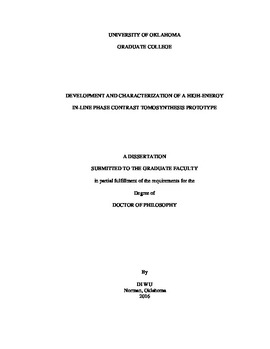| dc.contributor.advisor | LIU, HONG | |
| dc.contributor.author | WU, DI | |
| dc.date.accessioned | 2017-01-09T16:38:39Z | |
| dc.date.available | 2017-01-09T16:38:39Z | |
| dc.date.issued | 2016-12-16 | |
| dc.identifier.uri | https://hdl.handle.net/11244/47144 | |
| dc.description.abstract | Phase sensitive 3D imaging techniques have been an emerging field in x-ray imaging for two decades. Among them, in-line phase contrast tomosynthesis has been investigated with great potential for translation into clinical applications in the near future, due to combining the advantages of configuration simplicity, structural noise elimination and potentially low radiation dose delivery. The high-energy in-line phase contrast tomosynthesis technique developed and presented in this dissertation initiates this translational procedure by optimizing the imaging conditions, performing phase retrieval, offering opportunities to further reduce radiation dose delivery, improving detectability and specificity with the employment of auxiliary phase contrast agents, and potentially performing quantitative imaging.
First, the high-energy in-line phase contrast tomosynthesis prototype was developed and characterized in this dissertation as the first of its kind following a number of engineering trade-off considerations. The quantitative results as well as the imaging results of tissue-simulating phantoms and biology-related phantoms demonstrate the extensive capability of this imaging prototype in improving tumor detectability. In addition, the optimization of the x-ray prime beam toward the PAD phase retrieval method proved the potential of high-energy imaging and predicated the solution toward imaging time reduction by employing photon counting based imaging techniques.
In the past several years, applications of microbubbles as a phase contrast agent have shown the capability for image quality improvement in quantitative imaging. In this dissertation, a preliminary study of quantitative imaging of microbubbles using the in-line phase contrast projection mode imaging prototype, which is a system without tomosynthesis capability, provided a discussion on how the materials of the bubble shells and gas infills could impact the imaging capabilities and resulting image detectability. In addition, the results of the study provided a guideline for microbubble selections for in-line phase contrast mode imaging modalities. Based on this criterion discussed in the study, the albumin-shell microbubbles were selected as the phase contrast agent for the imaging prototype presented in this dissertation. The imaging results showed the feasibility of performing quantitative imaging by employing microbubbles as the auxiliary phase contrast agent. Clinical conditions were simulated by distributing microbubbles on the interface between two tissue-like phantom structures. The quantitative imaging results provided clinical motivation for translating phantom studies into more biology-related investigations providing radiation dose reductions in the future. | en_US |
| dc.language | en_US | en_US |
| dc.rights | Attribution-NonCommercial-NoDerivs 3.0 United States | * |
| dc.rights.uri | https://creativecommons.org/licenses/by-nc-nd/3.0/us/ | * |
| dc.subject | Engineering, Biomedical. | en_US |
| dc.title | DEVELOPMENT AND CHARACTERIZATION OF A HIGH-ENERGY IN-LINE PHASE CONTRAST TOMOSYNTHESIS PROTOTYPE | en_US |
| dc.contributor.committeeMember | CHENG, QI | |
| dc.contributor.committeeMember | ZHENG, BIN | |
| dc.contributor.committeeMember | GOODMAN, NATHAN | |
| dc.contributor.committeeMember | YANG, KAI | |
| dc.date.manuscript | 2016-12-08 | |
| dc.thesis.degree | Ph.D. | en_US |
| ou.group | College of Engineering::School of Electrical and Computer Engineering | en_US |
| shareok.orcid | 0000-0002-9970-0845 | en_US |

